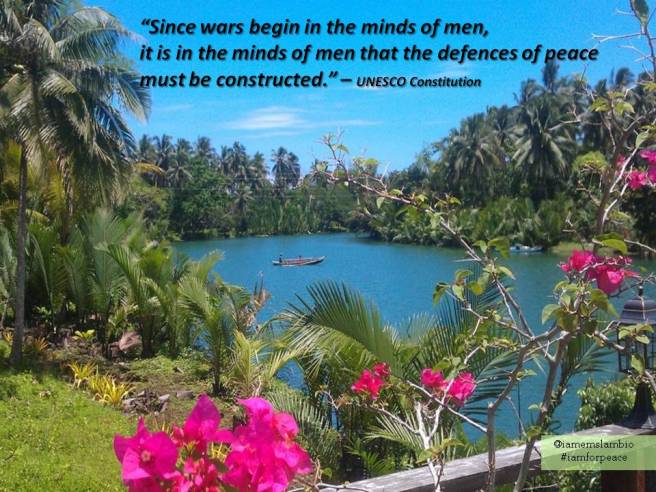Do you still remember what Dumbledore told Harry Potter when Harry doubted himself for a moment because he has the same abilities as the one whose name shall not be named?
The great Albus Dumbledore said,
“It is our choices, Harry, that show what we truly are, far more than our abilities.” [1]

I couldn’t agree more, Dumbledore! Choices or the decisions one makes are what defines a hero, the good and the bad. But how do we raise children who would choose integrity, fairness, and generosity so that he or she might be able to help build a just society; choose dialogue, collaboration and other peaceful means of resolving conflict so that there would be no more war; choose to protect this earth so that all may have enough?
I believe, peace education have answers for this. It is a transformative education that is teaching for and about human rights, gender equality, disarmament, social and economic justice, non-violence, sustainable development, international law, and traditional peace practice. [2]
The world is full of violence – not just those that kill but also those that deprive us of our human dignity and capacity to reach our full human potentials. This form of violence called structural violence is embedded in our culture, policies and socio-economic structures.[3] If we don’t act now to nurture the sensitivity of our children to manifestations of violence (i.e. corruption, poverty, gender inequality, man-made environmental degradation; prejudice against minority groups; marginalization of indigenous people; etc.) and teach them the values and skills of peace, then violence might become the norm of the next generation.
Those children from Syria would not have drowned, if their families didn’t have to escape war in their homeland. Citizens of atoll[4] nations, whose country is sinking because of global warming intensified by burning fossil fuels, would not have to face an uncertain future as climate change refugees. Other Muslims in Mindanao should not have been treated with prejudice, just because there are Muslims who wage war with the government. Children from indigenous communities in Surigao del Sur shouldn’t be missing their classes and camping now in depressing evacuation areas because of security threats in their communities. These and so many real life stories of violence – physical or structural, need to end. While considerable efforts must be done today to protect and secure the rights of vulnerable people and address root causes of violence, we also must invest for the future to keep these from happening again.
Peace education could provide a pathway away from cycles of violence by enhancing our children’s abilities for “critical thinking, reflection and participation”[5] and broadening their perspective on peace. This kind of education aims to contribute to building a culture of peace which “consists of values, attitudes and behaviors that reject violence and prevent conflicts by tackling their root causes to solve problems through dialogue and negotiation among individuals, groups and nations.”[6]
Building a culture of peace is not just the responsibility of teachers. Anyone can make a contribution. This can be integrated in school curricula, community projects, mass media, homilies, and even bedtime stories. The key is to start with a clear purpose and begin now! While, it may be a long and difficult journey, our efforts, whether big or small, could bear sweet fruits someday.
In parting, I’d like to share a peace quote that I superimposed in this photo of Loboc River that I took one beautiful summer in Bohol, Philippines:
Let us nurture the minds of children for peace. Remember what Dumbledore said, we all have choices. Please say you’ll choose peace.
Have a wonderful week!
-ems, #iamforpeace
References:
[1] Rowling, J. K., 1998. Harry Potter and the Chamber of Secrets.
[2] Castro, L. and Galace, J., 2008. Peace Education: A Pathway to a Culture of Peace.
[3] Galtung, J., 1960. Violence, Peace and Peace Research.
[4] An atoll is a ring-shaped coral-reef, island or series of islets, enclosing a lagoon. Atoll nations are low-lying countries that are only a few meters above sea level.
[5] Castro, L. and Galace, J., 2010. Peace Education: A Pathway to a Culture of Peace.
[6] United Nations.Educational, Scientific, and Cultural Organization (UNESCO).


I love the quote. It is one my favourite on choices.
I thoroughly enjoyed the read.
Have a great weekend!
~Arcane owl
LikeLiked by 1 person
Hello Arcane Owl, I really like also those words of Dumbledore, so full of wisdom. Glad you enjoyed this post…
thanks for dropping by and for the Inside Out tip 🙂 happy weekend!
– ems
LikeLiked by 1 person
Hey Emily
I’m glad to have come across your blog 😉
Have a great weekend!
Arcane owl
LikeLiked by 1 person
Great blog. Very meaningful post. The concept of choice is an interesting one. I agree that we should choose peace, but why do so many people, especially those in power, choose violence?
LikeLiked by 1 person
It’s a sad reality indeed, one that can change however if we can all learn a little bit more of empathy and compassion…then we might perhaps be a bit more creative and find better solutions to our issues of conflict…because violence should never be an option.
Thank you for your kind comments. I am energized to carry on 🙂
LikeLike
Reblogged this on Laurie Woodward and commented:
Thank you, Emily, for reminding us that peace is a choice.
LikeLiked by 1 person
Indeed it is…and not an easy one…we need all the encouragement and to equip ourselves with the abilities to keep choosing peace… Thank you Laurie.
LikeLike